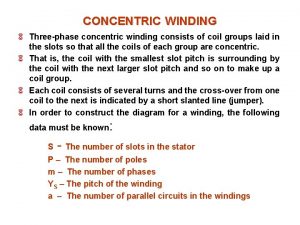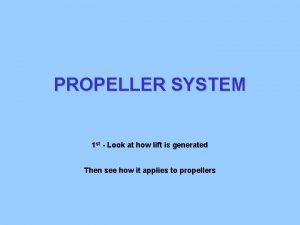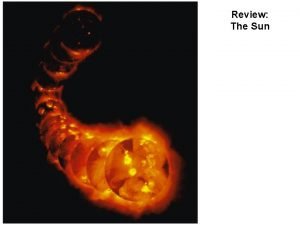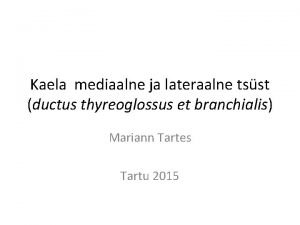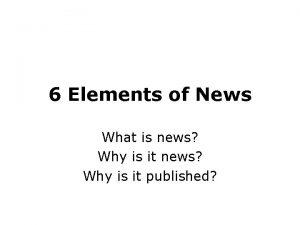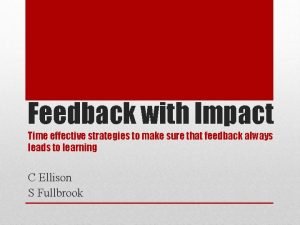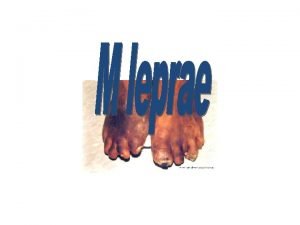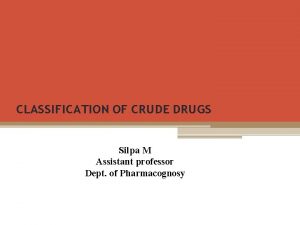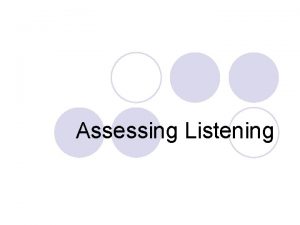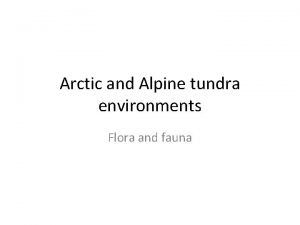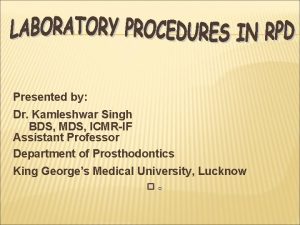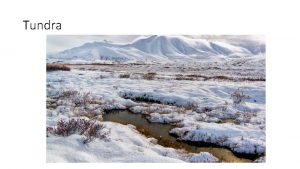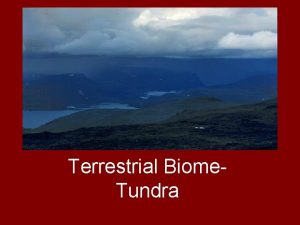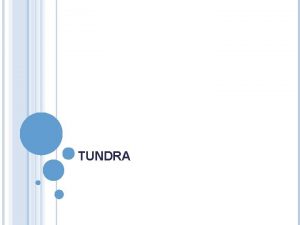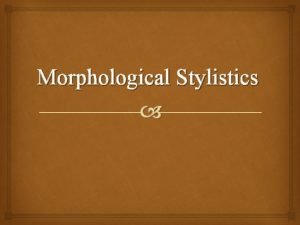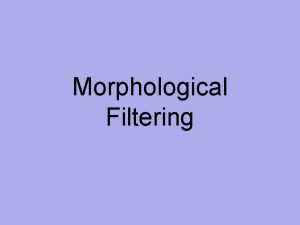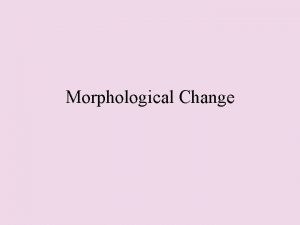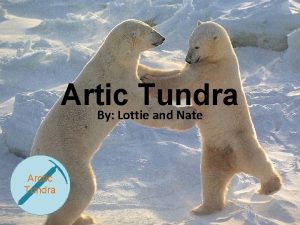Morphological focus marking and pitch prominence in Tundra





























- Slides: 29

Morphological focus marking and pitch prominence in Tundra Yukaghir Dejan Matic & Cecilia Odé dejan. matic@mpi. nl, c. ode@uva. nl


Focus and Stress • Universality of focus-stress correspondence – Basic Focus Rule: An accented word is F(ocus)-marked (Selkirk 1995: 555) – Stress-Focus Correspondence Principle: The focus of a clause is a(ny) constituent containing the main stress of the intonational phrase, as determined by the stress rule (Reinhart 1995: 62) – Focus: A Focus-marked phrase contains an accent (Schwarzschild 1999: 173) – Stress-Focus: A focused phrase has the highest prosodic prominence in its focus domain (Féry & Samek-Lodovici 2006: 135 -6)

Focus and Stress (cont. ) • Counterexamples – Tone languages using local changes of pitch range instead of stress/pitch accents (cf. e. g. Xu 1999 for Mandarin) – Languages which use prosodic phrasing to mark focus instead of stress/pitch (cf. e. g. Pierrehumbert & Bekman 1988 for Japanese, Kanerva 1990, Downing et al. 2004 for Chichewa, Koch 2008 for Thompson River Salish) – Languages without any correlation between focus and prosody (cf. e. g. Rialland & Robert 2001 for Wolof, Lindström & Remijsen 2005 for Kuot, Zerbian 2007 for Sotho, Hartmann & Zimmermann 2007 for Hausa)

Focus and Stress (cont. ) • No correlation between focus and prosody: languages with morphological focus marking (Wolof, Kuot, Hausa) • Does morphological focus marking imply lack of prosodic marking of focus? • The purpose of the talk: Describe the interaction of prosody and focus in a non-tonal language with (partial) morphological focus marking

Yukaghir • Tundra Yukaghir and Kolyma Yukaghir: a small language family of north-eastern Siberia, perhaps distantly related to Uralic (cf. Fortescue 1998, Nikolaeva 2000: 25 ff. , 2006) • Tundra Yukaghir: 50 -55 mostly elderly speakers (as of summer 2010): – villages of Andrjushkino and Kolymskoe in the Lower Kolyma Tundra (35 -40 speakers) – the village of Cherksy (13 speakers) – Yakutsk (5 speakers)

Tundra Yukaghir

Maria N. Tokhtosova, Il’ja I. Kurilov, Vasilij N. Tret’jakov, Maria N. Kurilova

Anna E. Tret’jakova, Fedosija I. Kurilova, Ala: ji

Olera Tundra, village of Andrjushkino, yurt in Toghoj near Andrjushkino

Focus Marking in Tundra Yukaghir • Focused core arguments (S and O) – focus case -le(ŋ) or -(e)k – S- or O-focus agreement on the verb (1) – Neme-leŋ iŋeː-meŋ? what-FOC fear-OF. 1/2 SG – Labunmə-leŋ iŋeː-meŋ. ptarmigan-FOC fear-OF. 1/2 SG “ – What do you fear? – I fear ptarmigans. ” (K 05: 240)

Focus Marking in Tundra Yukaghir (cont. ) • Focus on the verb – no focus case – particle me(r)= + ‘neutral’ verb agreement (2) Tada: t me=kew-eč. Taŋ l'eml'e-pul-ŋin then VFOC=go-PF. INTR(3 SG) that chief-PL-DAT nime-γe me=segu-j house-LOC VFOC=enter-INTR(3 SG) “Then he left. He entered the house of their chief. ” (K 05: 150)

Focus Marking in Tundra Yukaghir (cont. ) • Focus on oblique arguments/adjuncts – no focus case, no particle mə(r)= – ‘neutral’ verb agreement (3) – Qaduŋudeŋ kew-ej? whither go-PF(3 SG) – Moskva-ŋiń keweč. Moscow-DAT go-PF. INTR(3 SG) “ – Where did he go? – He went to Moscow. ” (fd_DM 08)

Focus Marking in Tundra Yukaghir: Summary Focus case + Focus agreement Focus on S/O Focus on oblique Focus on verb Neutral agreement Particle mə(r)=

Experiment • Purpose: – presence of pitch prominence on focusmarked S’s and O’s; – similarities in F 0 prominence patterns of focus -marked S/O’s, non-focus-marked focused obliques, and mə(r)=-marked verbs; – differences in F 0 prominence patterns between broad and narrow focus construals

Experiment (cont. ) • Setup – 4 speakers (Andrjushkino and Chersky) – question-answer pairs (Xu 1999) • with explicit contrast (Is it X? It is Y, not X) • without contrast (What is it? It is X) – five focus constellations (SFoc, Obl. Foc, VFoc, Broad. Foc) – 33 q-a pairs X 4 speakers = 132 pairs – Reading intonation avoided via multiple repetition (Zerbian 2007)

Results 1: Focused Subjects and Objects • In all instances: pitch prominence on S/O with morphological focus marking • Pitch movement: falling pitch on focused S/O, followed by low pitch (no perceptually relevant pitch movements after focused S/O) • Morphological focus marking AND pitch prominence

Results 1: Focused Subjects and Objects (4) Eguojie kin-ek jaqte-te-l? Apanala: -leŋ jaqte-te-l. tomorrow who-FOC sing-FUT-SUB. FOC old. woman-FOC sing-FUT-S. FOC “Who is going to sing tomorrow? ” “The/an old woman will sing. ” (5) Ivan kin-ek juo-mele? Tudel apanala: -leŋ juo-mele. I. who-FOC see-OBJ. FOC. 3 sg He old. woman-FOC see-OBJ. FOC. 3 sg “Who did Ivan see? ” “He saw the/an old woman. ”

Results 2: Focused Obliques • In all instances: pitch prominence on focused obliques without morphological focus marking • Pitch movement: falling pitch on focused elements, followed by low pitch (no perceptually relevant pitch movements after focused oblique) • The same type of pitch prominence as with morphologically focus-marked S/O’s

Results 2: Focused Obliques (6) Tet ama: qańin kelu-Ø? you father when arrive-INTERR. 3 sg Tudel awja: kelu-j. he yesterday arrive-INTR. 3 sg “When did your father arrive? ” “He arrived yesterday. ”

Results 3: Focused Verbs • In most instances (2 exceptions): pitch prominence on focused verbs marked with particle me(r)= • Pitch movement: falling pitch on mə(r)=, followed by a rise and a fall on the last syllable. • The first pitch movement identical to other focus-triggered pitch movements • Unclear status of the final rise and fall (end of the intonational phrase)

Results 3: Focused Verbs (7) Tu-ŋ adil qa: lid'e-le me=jewligi-m? DEM-ATTR young. man wolf-ACC VFOC=like-TR. 3 sg Ele: ń, adil qa: lid'e-le mer=iŋie-m. no young. man wolf-ACC VFOC=fear-TR. 3 sg “Does that young man like wolves? ” “No, the young man is afraid of wolves”

Results 4: Narrow Focus & Broad Focus • Broad focus (answer to questions “What happened? ” “What does X do? ”) expressed with the same morphological means as narrow focus on S – focus case (-le(ŋ) or -(e)k) + S/O focus agreement • No detectable prosodic differences: falling pitch on S/O followed by low pitch level

Results 4: Narrow Focus and Broad Focus (8) Tudel adi-leŋ uba: -mele? he young. man-FOC kiss-OBJ. FOC. 3 sg El=adi-leŋ, met-ek uba: -mele. NEG=young. man-FOC me-FOC kiss-OBJ. FOC. 3 sg “Did she kiss the young man? ” “Not the young man - she kissed me. ” (narrow) (9) Tudel neme-le wie-mele? Met-ek uba: -mele. he what-FOC do-OBJ. FOC. 3 sg me-FOC kiss-OBJ. FOC. 3 sg “What did she do? ” “She kissed me. ” (broad)

Results 5: The Role of Contrast • Are there differences in pitch movement with contrastive foci in comparison to those which do not stand in immediate contrast to salient alternatives? • No detectable prosodic differences: falling pitch on S/O followed by low pitch level

Results 5: The Role of Contrast (4) Eguojie kin-ek jaqte-te-l? Apanala: -leŋ jaqte-te-l. tomorrow who-FOC sing-FUT-SUB. FOC old. woman-FOC sing-FUT-S. FOC “Who is going to sing tomorrow? ” “The/an old woman will sing. ” (no contrast) (10) Eguojie pa: d'eduo-leŋ jaqte-te-l? tomorrow girl-FOC sing-FUT. SUB-FOC El=pa: d'eduo-leŋ, apanala: -leŋ jaqte-te-l. NEG=girl-FOC old. woman-FOC sing-FUT-SUB. FOC “Will the girl sing tomorrow? ” “Not the girl, the old woman will sing. ” (contrast)

Retrospects • Morphologically marked focus on S/O is redundantly prosodically marked. • The same type of pitch prominence is found on foci which are not morphologically marked and (to a certain extent) on morphologically marked verbs. • Contrast and focus scope play no role in pitch prominence asignment. ⇨ Falling pitch followed by low pitch level is a marker of focus in TY across different types of focus marking

Retrospects (cont. ) Prosodic marking of focus and morphological focus systems are typologically not mutually exclusive

Prospects • Deepening the analysis: duration and intensity in addition to F 0; more comparison across sentences • Enhancing the data set: – further variabales (positional, etc. ) – corpus data • Perception experiments (matching questions to answers and vice versa)
 Back pitch and front pitch
Back pitch and front pitch Concentric winding
Concentric winding Ac armature winding
Ac armature winding Cyclic pitch vs collective pitch
Cyclic pitch vs collective pitch How to calculate tube pitch in heat exchanger
How to calculate tube pitch in heat exchanger Coarse pitch vs. fine pitch propeller
Coarse pitch vs. fine pitch propeller Baseball parent meeting agenda
Baseball parent meeting agenda Doença
Doença A solar prominence from soho
A solar prominence from soho Laryngeal prominence
Laryngeal prominence Prominence news value
Prominence news value Essentials of news
Essentials of news Values of news
Values of news Porters generic competitive strategies
Porters generic competitive strategies Differentiation cost leadership
Differentiation cost leadership Prolepsis
Prolepsis Actor focus vs object focus
Actor focus vs object focus Tick and flick marking
Tick and flick marking Rhino marking
Rhino marking Mitsuda reaction
Mitsuda reaction Coriander, fennel, datura are examples of
Coriander, fennel, datura are examples of Listening answer
Listening answer Tundra fauna and flora
Tundra fauna and flora Facts about the tundra
Facts about the tundra Biome background
Biome background Automated exam marking
Automated exam marking National 5 pe portfolio understanding standards
National 5 pe portfolio understanding standards Rag marking
Rag marking Indirect retainer in rpd
Indirect retainer in rpd Tripod marking in rpd
Tripod marking in rpd

